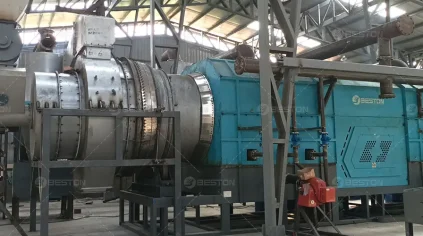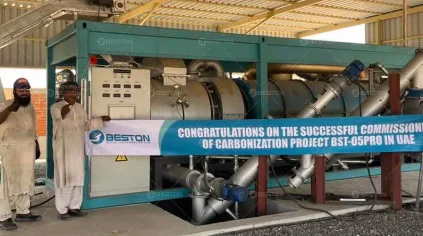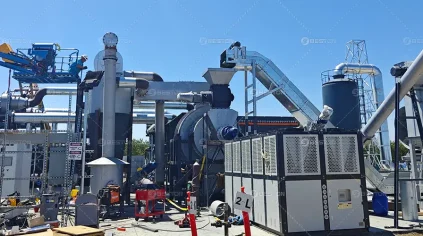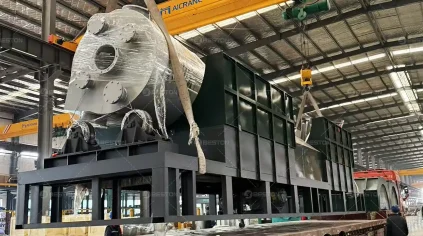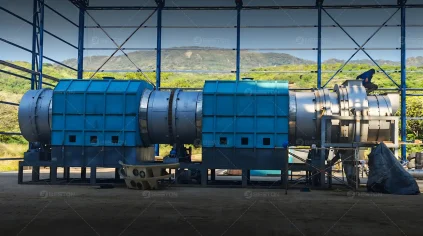
Straw charcoal machine converts agricultural waste into up to 6,000 tons of biochar per year. The biochar produced meets EBC standards and is perfect for soil enhancement and carbon sequestration. This solution supports sustainable agriculture, circular economy, and climate change mitigation. If you’re facing excess straw disposal challenges, please contact us for a recycling solution.
Why Choose Straw to Charcoal Solution? – A Comparative Analysis
Annually, billions of tons of agricultural straw waste are generated worldwide, with corn straw, rice straw, and sugarcane bagasse being the most prevalent. Traditional disposal methods have limitations. The straw charcoal making machine (bichar making machine) offers a sustainable alternative, benefiting both the environment and economy.
| Treatment Method | Environmental Impact | Utilization Rate | Soil Improvement Effect | Economic Value | Notes |
|---|---|---|---|---|---|
| Burning | ❌ Very Poor | ❌ Low | ❌ Harmful | ❌ None |
|
| Straw Returning | ⚠️ Moderate | ⚠️ Medium | ⚠️ Short-term effects | ⚠️ Moderate |
|
| Feed Processing | ✅ Sustainable | ⚠️ Medium | ➖ No direct effect | ⚠️ Moderate |
|
| Power Generation | ✅ Sustainable | ⚠️ Medium | ➖ No direct effect | ⚠️ Moderate |
|
| Biochar Production | ✅✅ Excellent sustainability | ✅ High | ✅ Great improvement | ✅ High |
|
Beston Biomass Pyrolysis Technology Meets Puro.earth Standards
The biomass pyrolysis technology developed by Beston Group has been vetted by Puro.earth, a leading global platform for carbon removal. By deploying our vetted straw charcoal machine (BST-50S model), businesses can not only generate value from agricultural waste but also participate in the international carbon market.

Parameters of Straw Charcoal Machine

BST-50S Model
- BST-50S technology vetted by Puro.earth
- 6,000 tons biochar production annually
- 7200H/Y stable&safe operation
- 4 configuration options

BST-06 Model
- 8000H/Y stable&safe operation
- Low-cost carbon removal process verification
- Small-scale test machine
- 2 configuration options
| Model | BST-50 Standard | BST-50S LM | BST-50S HM | BST-50S MAX | BST-06 Standard | BST-06MAX |
|---|---|---|---|---|---|---|
| Time to Market | 2015 | 2022 | 2022 | 2022 | 2025 | 2025 |
| Operating Mode | Continuous | Continuous | Continuous | Continuous | Continuous | Continuous |
| Application | Commercial Scale | Commercial Scale | Commercial Scale | Commercial Scale | Testing | Testing |
| Dust Removal System | Standard | Advanced | Advanced | Advanced | Standard | Advanced |
| Feeding Capacity | 10-15m³/h | 10-15m³/h | 10-15m³/h | 10-15m³/h | 100-300KG/H | 100-300KG/H |
| Biochar Discharge Temperature | 45℃ | 45℃ | 45℃ | 45℃ | 45℃ | 45℃ |
| Puro.earth Authentication Model | × | √ | √ | √ | × | |
| Maximum Pyrolysis temperature | 650℃ | 650℃ | 650℃ | 850℃ | 650℃ | |
| Service Life | 5-8 years | 5-8 years | 5-8 years | 8-10 years | 5-8 years | |
| Annual Operating Time | 7200 hours | 7200 hours | 7200 hours | 7200 hours | 8000 hours | |
| Land Space Required (L*W*H*m) | 35m×15m×8m | 65m×15m×8m | 65m×15m×8m | 65m×15m×8m | 25m*18m*6m | |
| Total Power (KW) | 201.25kW | 453.35kW | 505.35kW | 505.35kW | 129.79 | 162.79 |
| Cooling Method | Recycling cooling Water | Industrial chiller | Industrial chiller | Industrial chiller | Recycling cooling Water | Industrial chiller |
| Installation Period (Calendar Days) | 50 | 70 | 70 | 70 | 45 | 50 |
BST-50S: 6,000 Tons Biochar / Year = 12,000 Tons CO₂ Sequestration

Advanced Technologies Behind BST-50S: Support Carbon Sink Potential

Tar Dust Self-cleaning System
Pipe insulation prevents the condensation of tar and wood vinegar, avoiding blockages. The nitrogen purging system prevents the accumulation of high-temperature dust and pipe blockages.
Key Effect:
- 7,200 hours of operation time per year
Dual-cylinder Rotary Reactor
This achieves a staged and complete carbonization effect. The inner cylinder achieves the drying and partial carbonization of the straw. The outer cylinder further ensures complete carbonization.
Key Effect:
- > 10 m³/h processing capacity
High-Temperature Pyrolysis Process
A controlled high-temperature environment maximizes fixed carbon retention while minimizing ash and impurities. This ensures high-quality biochar suitable for advanced applications.
Key Effect:
- Final straw biochar meets EBC standards.
Low-Nitrogen Combustion Design
It enhances combustion efficiency, reduces incomplete fuel combustion, and indirectly lowers greenhouse gas emissions, better meeting emission standards.
Key Effect:
- Low N₂O emission (SGS tested)
- Low CH₄ emission (SGS tested)
Advanced Gas Treatment System
The high-end exhaust gas treatment system cools, removes particulate matter, desulfurizes, denitrifies, and adsorbs harmful substances from exhaust gases.
Key Effect:
- Meet strict European emission standards.
- Meet strict Singapore emission standards.
Sealed Combustion Design
It ensures more complete combustion of syngas and fuels, reaching sufficient combustion temperature and residence time as the pyrolysis reaction requires.
Key Effect:
- BST-50S meets Puro Criteria 1: Methods to ensure complete combustion of pyrolysis gases and oils
Technical Principle of Straw Charcoal Machine
01 Pretreatment
02 Feeding
03 Pyrolysis
Under high temperatures (380-450℃), agricultural straws decompose. At 150 ℃, some of the raw materials start to decompose into CO, CO2, etc. At 350 ℃, charcoal appears continuously.
04 Syngas Recycling
04 Cooling Discharging
Straw biochar is water-cooled via heat exchange and discharged at a temperature below 45 °C.
05 Dedusting
Once the residual heat in the waste gas is recovered, the remaining exhaust requires proper treatment. A dedusting system (cyclone dust remover, spray dust collector, etc.) will remove harmful components such as sulfur from it.
Various Straw Raw Materials for Biochar Production

Cereal Crop Straws
Representatives: Wheat straw, corn stalks, rice straw, sorghum stalks, etc.
- High cellulose and hemicellulose content, low ash content (below 5%)
- Moderate biochar yield (~25–35%).
- Widespread and readily available
Cotton and Fiber Crop Stalks
Representatives: Cotton stalks, flax stalks, jute stalks, etc.
- High cellulose content (40–50%), low ash content
- Moderate to high biochar yield (30–45%)
- Resulting biochar has a highly porous structure, large surface area, and excellent adsorption capacity


Legume Crop Residues
Representatives: Soybean straw, peanut vines, broad bean stalks
- Relatively high lignin content (25% or more), low ash content
- Higher biochar yield (30–40%)
- Good combustion properties
How to Profit from Straw Charcoal? – Practical Applications

Soil Improvement Project
Sell straw biochar to large farms and environmental organizations for soil remediation and fertility enhancement. It improves soil structure, retains nutrients, and promotes microbial activity.
Carbon Removal Project
Partner with carbon offset programs or organizations. As a stable form of carbon, straw biochar qualifies for carbon removal and supports long-term carbon sequestration strategies.
Green Building Materials
Supply straw biochar to construction material manufacturers. Added to concrete and composites, it cuts carbon emissions by 30% and improves thermal insulation and structural strength.
Renewable Energy Fuel
Sell straw charcoal briquettes to the catering industry, especially the BBQ market.
Sell straw charcoal to energy-intensive industries aiming to reduce fossil fuel dependence.
Metallurgical Applications
Provide straw charcoal to metal smelting plants as a renewable metallurgical reducing agent. It replaces coal-based products in the smelting process.
Livestock Feed Additives
Offer biochar to feed manufacturers and livestock farms. Used as a feed additive, it promotes animal gut health, reduces methane emissions, and aligns with the goals of sustainable livestock management.
Straw to Biochar: Closing the Loop in Sustainable Agriculture

01 From Straw to Biochar
Crop residues like wheat, rice, and corn straw are converted into biochar through pyrolysis using straw charcoal machine. This clean process prevents open burning, reduces pollution, and locks in carbon that would otherwise enter the atmosphere.
02 Biochar Back to the Soil
The biochar produced meets EBC-Agro standards and is ideal for farmland application. When added to soil, it enhances aeration, boosts water retention, and binds nutrients. This creates a better environment for plant growth.
03 Healthier Soil, Better Agriculture Harvest
As biochar improves soil structure and nutrient cycling, crops grow stronger and require fewer chemical inputs. It’s a smart investment in productivity and sustainability — all while cutting emissions and closing the loop.
Global Cases: Straw & More Biomass Recycling in Action
Full-Service for You – Get Informed via Document Procedures

Get Agricultural Straw Recycling Solution
Contact us to learn more about how straw charcoal machine supports the resource utilization of agricultural waste. Beston Group is committed to providing advanced and eco-friendly biomass pyrolysis solutions, serving a wide range of industries including agriculture, forestry, wood processing, food processing and more. For more updates, follow us on LinkedIn!

